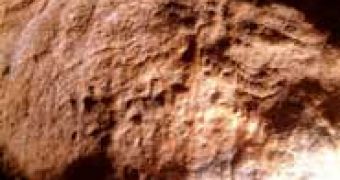Finally, the British can calm down: 13,000 years ago they were artists, just like those Spaniards and French, as a possible late Upper Palaeolithic ("Old Stone Age") engraving has been found at Cheddar Caves and Gorge by a team of the University of Bristol Speleological Society (UBSS).
The same team discovered in 2005 engravings dating probably from Mesolithic ("Middle Stone Age") at Aveline's Hole in Burrington Combe, Somerset and in Long Hole Cheddar Gorge.
The team, led by Graham Mullan and Linda Wilson, has carried out investigations in some Cheddar Gorge caves. The mammoth representation was discovered in a small alcove in the main showcave, Gough's Cave. The engraving has suffered some degradation as the rock surface was affected by the passing of time, but seems to be an outline drawing of a mammoth achieved by human made engraved lines added to some natural traits of the rock, a technique already found in the well known French and Spanish Ice Age decorated caves, like Altamira or Lacroix.
"This is a clear representation of an animal. We are more confident that at least part of it was humanly made and the subject material places it firmly in the latter part of the last Ice Age. Finds of mammoth ivory of that age have been made in this cave in the past indicating that these animals would have been known to the inhabitants." said lead researcher Grahan Mullan.
"Although the cave has been studied by many archaeologists, this engraving has previously escaped notice because it is quite difficult to make out. For this reason, a careful study has been made and this announcement was delayed until we were reasonably confident of the attribution." added Mullan.
"Had I been shown this outline of a mammoth during a visit to one of the well known cave art sites in France or Spain, I would have nodded and been able to accept it in the context of other more obvious pictures. Cave art is so rare here that we must always question and test to make sure we are getting it right. Opinions on this may differ but we do seem to be looking at an area of ancient rock surface and the lines which appear to form the head and back of the mammoth could have been made by a stone tool. They are certainly different from natural markings on the cave wall." said Jill Cook, Deputy Keeper in the British Museum's Department of Prehistory and Europe.
"This little cartoon might well represent a moment of quiet reflection by someone using the cave 13,000 years ago. It is yet another aspect of the site which suggests that the cave may have been special to the people who used it at the end of the Last Ice Age."

 14 DAY TRIAL //
14 DAY TRIAL //